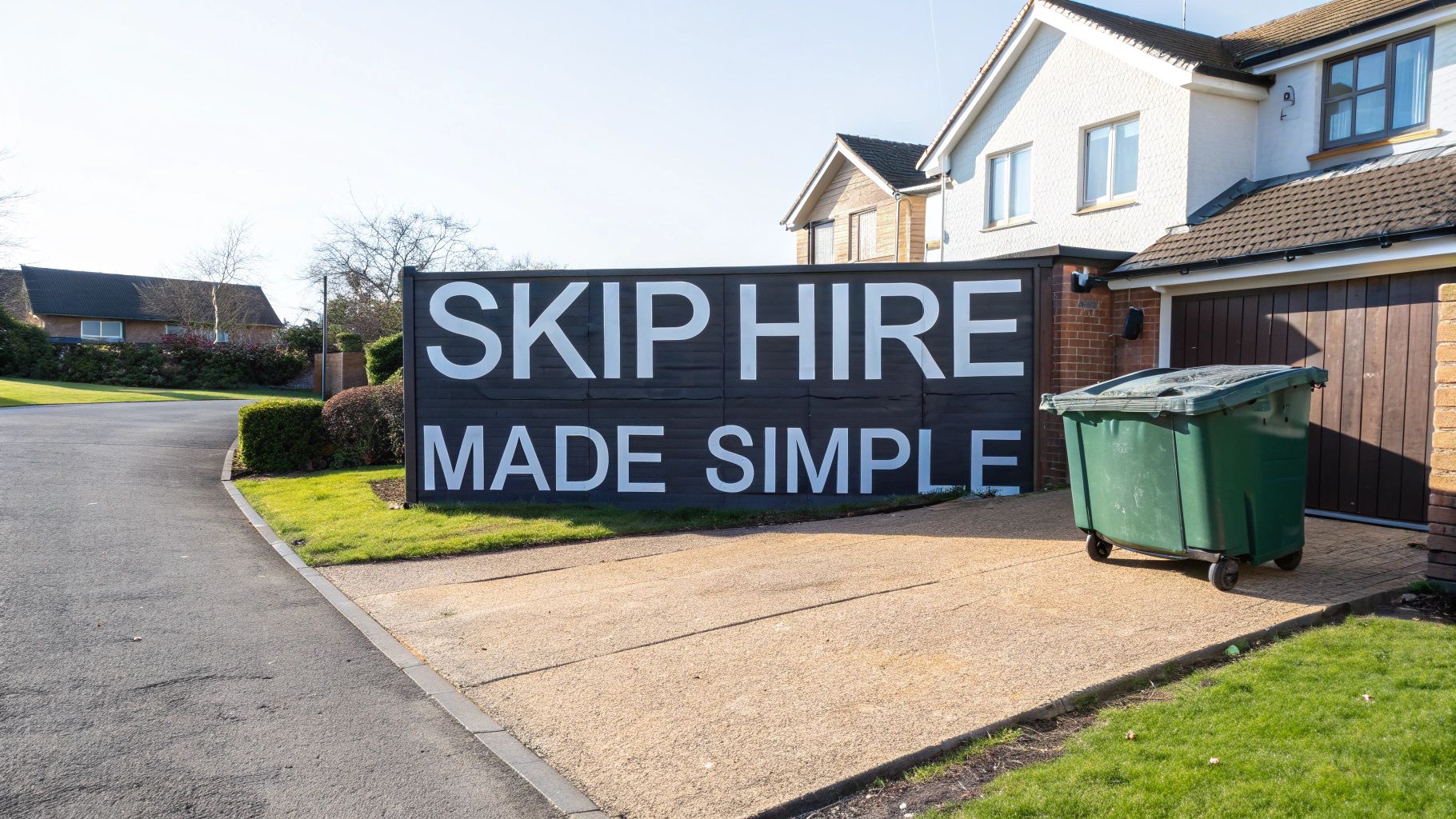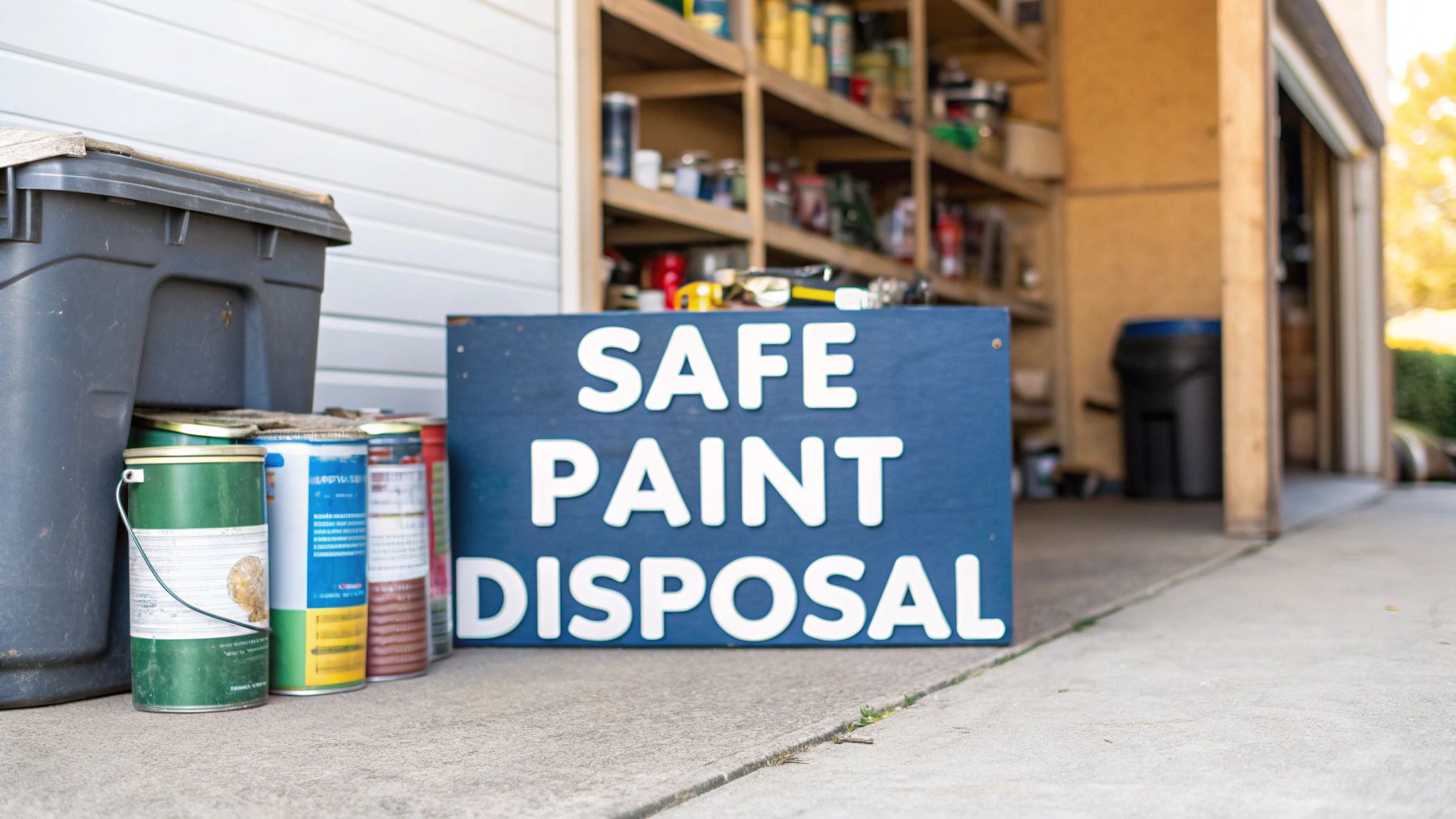4 Yard Skip Measurements Explained
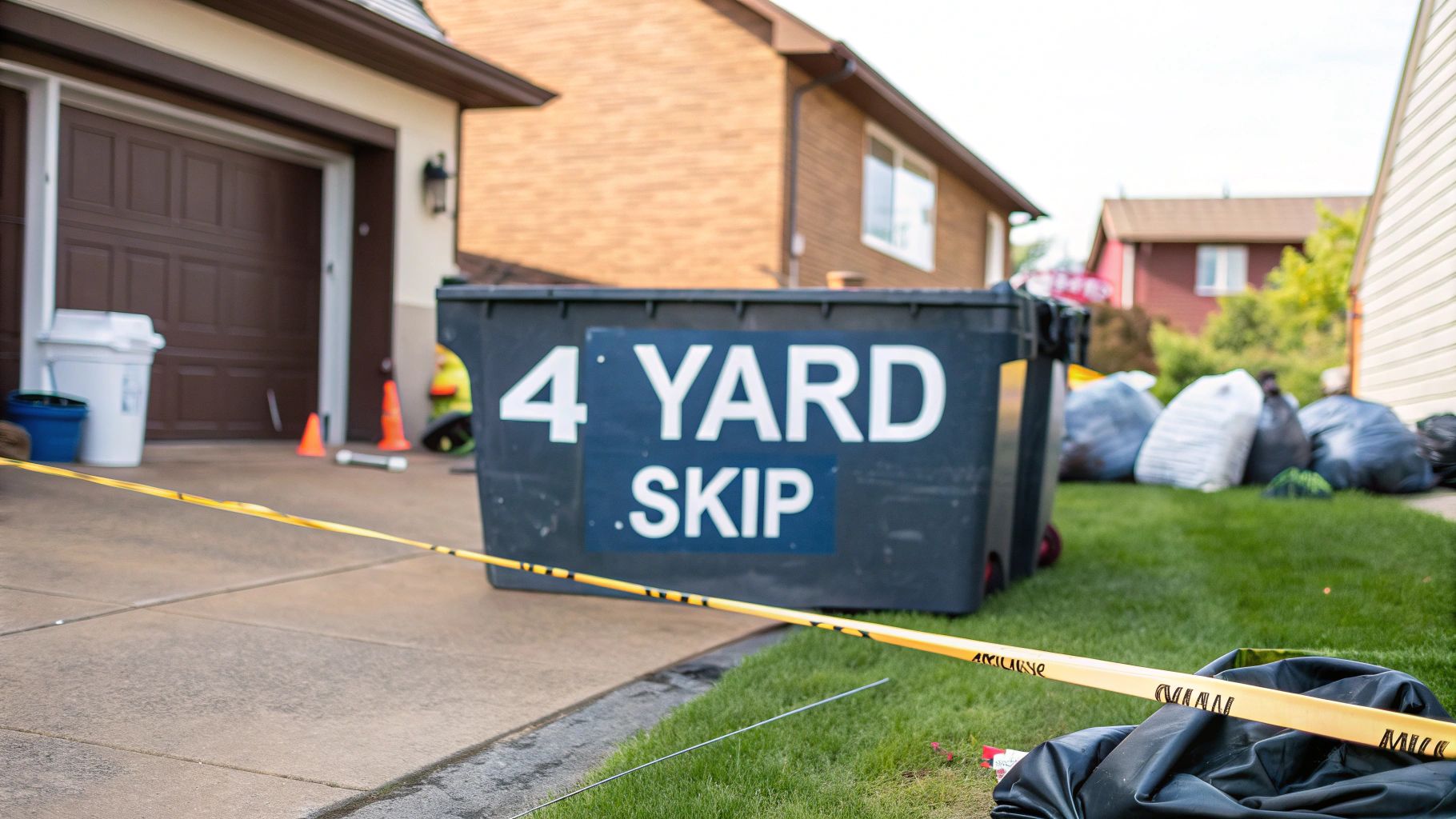
4 Yard Skip Measurements Explained
Right then, let's get straight to it. When you're looking at hiring a skip, the first question is always "Will it fit?". For the popular 4 yarder, you're looking at a footprint of roughly 1.8 metres long, 1.3 metres wide, and 1.0 metre high.
It’s often called a 'midi' skip, and that's a perfect description. It's the ideal middle-ground for jobs where your wheelie bin won't cut it, but a massive builder's skip would be overkill.
Your Guide to 4 Yard Skip Measurements
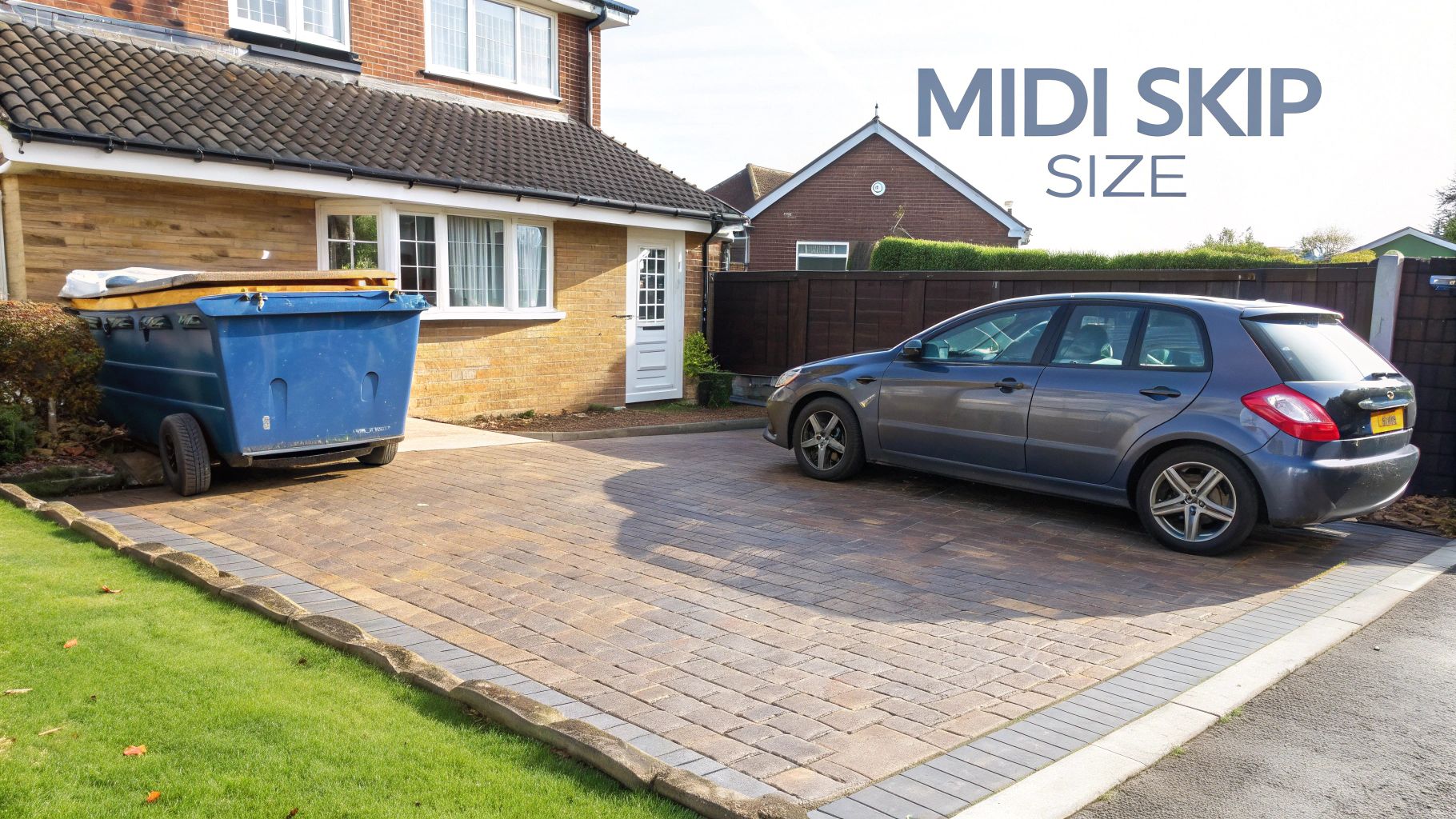
Knowing the numbers is one thing, but picturing it on your drive is another. The best way to visualise a 4 yard skip is to think of a small car – something like a Ford Fiesta or a Volkswagen Polo. If you’ve got room for one of those, you’ve got room for this skip.
The "4 yard" part refers to its volume, meaning it holds four cubic yards of waste. This makes it a firm favourite for all sorts of projects, from ripping out an old bathroom to finally tackling that overgrown garden. It bridges the gap perfectly between domestic waste and small-scale trade jobs.
To make things even clearer, we've put all the key details into a handy table. This gives you everything you need to know in one place, so you can quickly see if the midi skip is the right fit for your project.
4 Yard Skip At a Glance Dimensions and Capacity
This quick reference guide breaks down the typical measurements and capacity for a standard 4-yard midi skip.
| Metric | Typical Measurement or Capacity |
|---|---|
| Length | 1.8 metres (approx. 6 feet) |
| Width | 1.3 metres (approx. 4.3 feet) |
| Height | 1.0 metre (approx. 3.2 feet) |
| Volume | 4 Cubic Yards (3.06 Cubic Metres) |
| Bin Bag Capacity | 30 – 40 standard refuse sacks |
| Common Name | Midi Skip |
| Ideal For | Small renovations, garden clearances |
As you can see, it's a compact but surprisingly spacious option. Perfect for those jobs that generate a bit more mess than you'd expect
How Much Waste Can You Actually Fit Inside?
It’s one thing to know the 4-yard skip measurements in theory, but another thing entirely to picture how your mountain of rubbish will actually fit inside. The easiest way to get your head around the capacity is to think in terms of something we all know: the humble black bin bag.
A 4-yard skip can comfortably hold between 30 and 40 full bin bags. This makes it the go-to choice for jobs that produce a fair bit of bulky waste, but nothing too heavy – think clearing out the garage, getting rid of old wallpaper from a couple of rooms, or a small garden makeover.
Visualising The Volume
Let's talk projects. If you're ripping out a small bathroom, the old suite, tiles, and flooring should fit in there nicely. It's also spot-on for the soil and green waste you’d get from clearing out a few garden beds or levelling a small patch of lawn.
The image below gives you a great visual idea of what that looks like in practice, all stacked and ready to go.
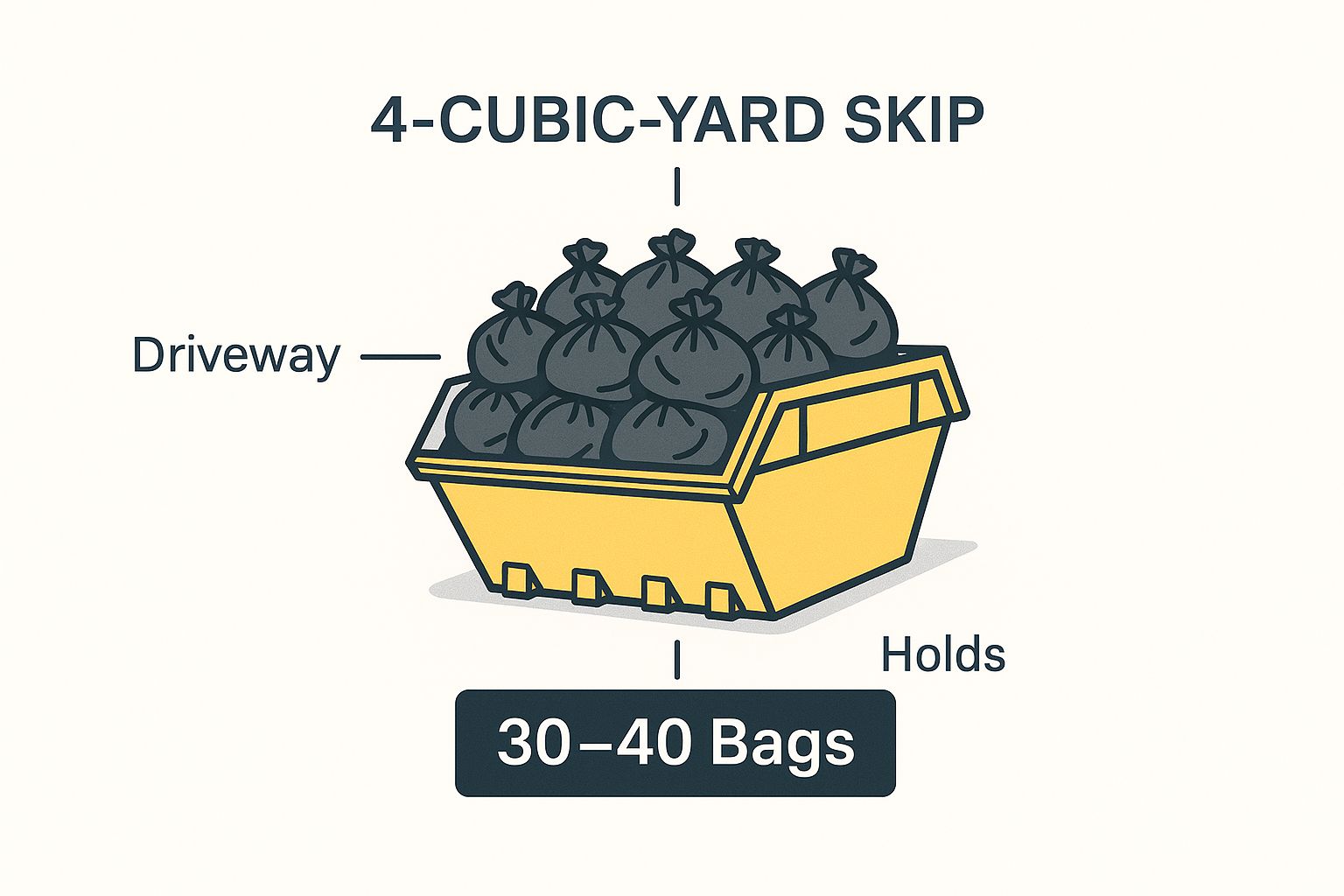
It really shows that even though it's called a "midi" skip, it packs a decent punch for most household and garden clear-outs. Getting the size right from the start means you won't have the headache or extra cost of ordering a second skip down the line.
It’s not just about the volume you have, but how you use it. Breaking down bigger items and filling all the empty pockets is the secret to getting real value from every cubic yard.
How you load your skip makes a massive difference. To push towards that 40-bag mark, you need to be a bit clever about it. For some top tips, have a look at our guide on https://www.thewastegroup.co.uk/news/how-to-fill-a-skip-for-maximum-efficiency/.
If you’re struggling to picture how your waste will stack up, you could check out online tools for calculating space requirements for a different way to think about volume. A little bit of planning upfront ensures you book the right skip for the job, saving you time and money in the long run.
Matching Your Project to the Midi Skip

Getting the numbers right is one thing, but figuring out if the 4 yard skip measurements actually fit your job is where it really counts. This midi skip is a real workhorse, hitting that sweet spot for projects that are way too big for your wheelie bin but don't quite need a massive industrial container.
It's in its element with common household jobs. Picture a small kitchen or bathroom renovation – all the old units, tiles, and flooring will fit in there nicely. It's also the perfect size for a proper garden clear-out, easily taking on soil, turf, branches, and even old patio slabs from an average-sized garden.
Common Uses for a 4 Yard Skip
The midi skip gets its popularity from a brilliant balance of holding a decent amount of waste while having a small, manageable footprint. It’s a firm favourite for:
- Decluttering projects: Ideal for finally clearing out the garage, loft, or shed.
- Minor renovations: Easily handles the waste from a single room makeover.
- Garden waste: Great for managing soil, green waste, and old fencing.
- Small building jobs: Takes care of rubble and offcuts from minor construction work.
Believe it or not, the skip hire industry is a huge part of UK waste management. A staggering 17 million skips are hired every year, and the vast majority are for domestic jobs. While there isn't official data breaking it down by size, the sheer volume of home projects tells you that smaller skips like the 4-yarder are incredibly common.
The real beauty of the 4-yard skip is its practicality. It fits neatly onto most driveways, meaning you often avoid the hassle and cost of a public road permit, yet it’s still big enough to get the job done right.
Picking the right size is crucial for any project. It’s a bit like using a self-storage size guide; you want to make sure you’re getting exactly what you need without paying for wasted space or finding you've not got enough. This helps you confidently match the skip's dimensions to your to-do list.
Navigating Weight Limits and Restricted Items
Getting a handle on the 4-yard skip measurements is a great start, but volume is only one part of the puzzle. You’ve also got to think about the weight of your waste. It’s a common mistake to assume that as long as there’s space, you can keep filling – but a half-full skip can easily be overweight if you’re chucking in the wrong stuff.
Most 4-yard skips can handle around 3-4 tonnes. That might sound like a huge amount, but you’d be surprised how quickly you can reach that limit, especially with heavy materials from garden or building work.
Think about it: soil, bricks, rubble, and concrete are seriously dense. You could hit that maximum weight allowance well before you run out of actual room in the skip, and that often leads to unexpected extra charges. A skip full of lightweight house clutter is a completely different ball game to one loaded with old patio slabs.
Prohibited Items You Cannot Skip
On top of weight, there are some pretty strict rules about what you can and can't throw into a general waste skip. These regulations aren't there to make your life difficult; they exist for critical safety and environmental reasons. Pop a restricted item in there, and you risk the whole load being rejected or getting hit with some hefty fines.
Here’s a quick rundown of the usual suspects you can’t put in a skip:
- Plasterboard: This has to be handled separately because of the chemicals it contains.
- Asbestos: An extremely hazardous material that needs a specialist team to remove it safely.
- Electronics (WEEE): Things like TVs, fridges, and computers require their own recycling process.
- Tyres and Batteries: They contain harmful chemicals and can’t just be buried in a landfill.
- Liquids: Paint, oils, solvents, and other liquids are a definite no-go.
Getting your head around these rules isn't just about ticking boxes; it's about making sure your project goes off without a hitch and without any nasty cost surprises. If you're ever in doubt, a quick call to your skip hire company will clear things up.
Understanding how skip weight limits work is vital for keeping your project on budget. To get the full picture, take a look at our detailed guide which explains if skips have a weight limit and what that means for you.
Planning For Your Skip Delivery And Placement
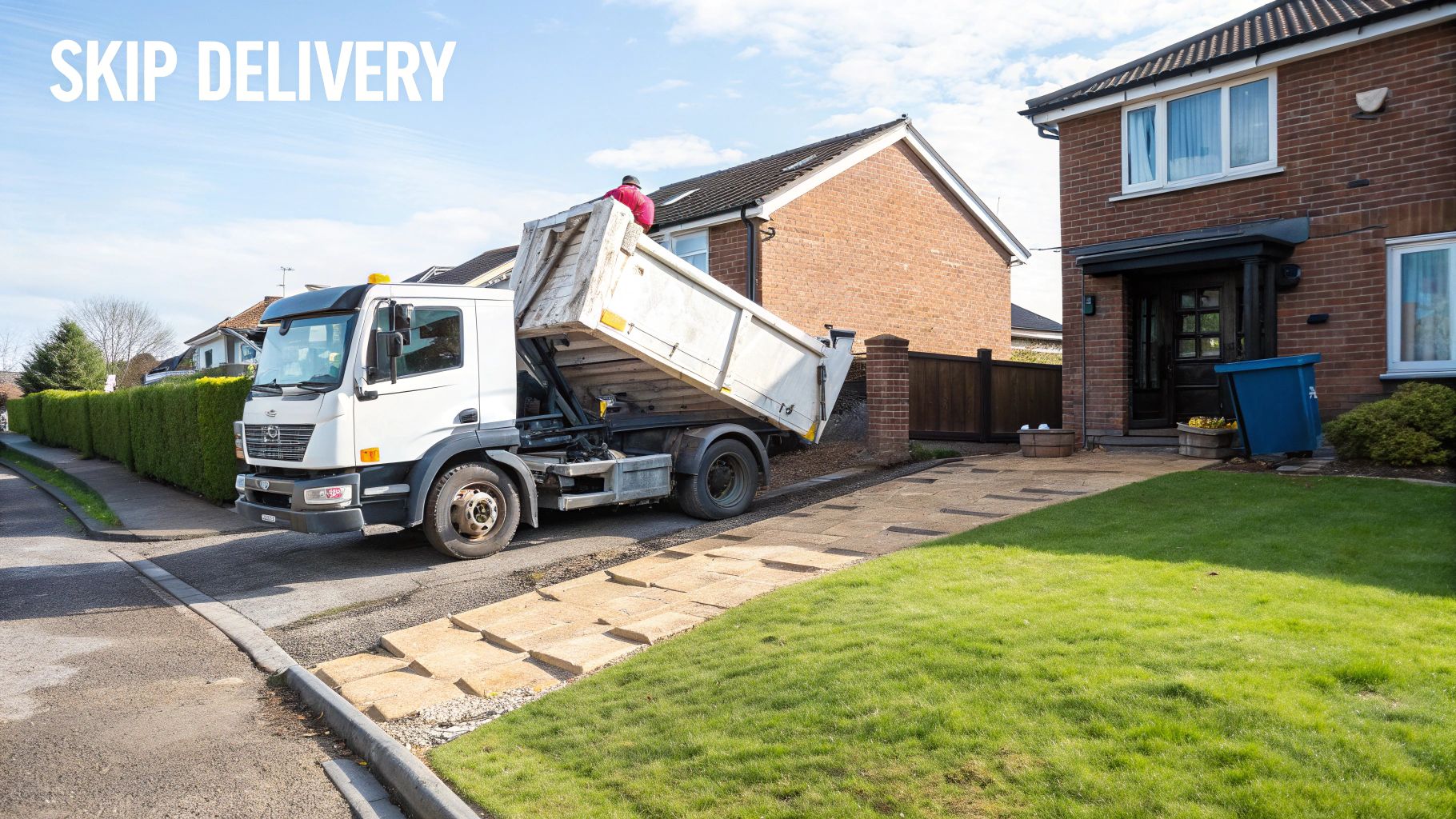
Knowing the 4 yard skip measurements is only half the battle. You also need to think about the practical side of things: getting the skip delivered and placed without a hitch. A bit of forward planning here ensures the delivery lorry has enough room to get in, drop the skip, and get out safely.
If it’s going on your own private land, like a driveway, you'll need to clear a space not just for the skip itself but also for the vehicle delivering it. Take a look around for anything that could get in the way – low-hanging tree branches, tight gateways, or even the family car. A quick check can save a lot of hassle on the day.
Placing A Skip On A Public Road
What if you don’t have a driveway or anywhere suitable on your property? In that case, the skip will need to go on the road, and for that, you absolutely need a skip permit from your local council. Don't skip this step!
Getting a permit sorted does involve a little admin. Councils have strict rules to keep the public safe, and this usually means:
- Applying in advance: You can't leave it to the last minute; give them several days' notice.
- Using safety gear: The skip might need to be fitted with safety cones and reflective markings or lights.
- Paying a fee: The cost varies from one council to the next.
It's really important to get this right to avoid any potential fines. Our guide walks you through everything you need to know about whether you need a skip permit and how to get one.
Common Questions About 4 Yard Skips
Even after covering the basics, a few questions always seem to come up when you’re looking to hire a midi skip. Getting these sorted from the outset is the key to a smooth project, helping you avoid any last-minute hitches. Let’s clear up a few of the most common queries.
One of the biggest questions we get is about mixing waste. Can you put heavy garden soil in with the general junk from a house clearance? In most cases, absolutely. A skip full of mixed waste is generally fine.
The main thing to watch out for is the weight limit. A skip loaded purely with dense stuff like soil, rubble, or concrete will hit its maximum weight far quicker than one filled with lighter household bits and pieces. Just be mindful of how much heavy material you're chucking in.
Understanding Key Details
People also wonder about the practical side of things – from how we work out the volume to whether they need to hang around for the delivery driver.
So, how is the ‘4 cubic yard’ volume actually calculated? It’s simply the internal length multiplied by the width and the height. Think of it like a big metal box: length x width x height = volume. This gives you the total usable space inside, giving you a standard measurement that’s consistent across the skip hire industry.
Another common one: "Do I need to be home for the delivery and collection?" Usually, no. As long as you give us clear instructions beforehand, you can get on with your day.
If the skip is going on your driveway, just make sure the space is totally clear of cars, bikes, or anything else that could get in the way. As long as our driver has safe and easy access, they can handle the drop-off and pick-up without you needing to be there.
This flexibility is a massive plus, meaning you don’t have to down tools and wait around. Just make your instructions are nice and clear to avoid any mix-ups with placement.
Finally, while we've gone over the external 4 yard skip measurements, remember the internal space is a tad smaller because of the thick steel walls. Don't worry, though – the '4 cubic yard' name already takes this into account, so it reflects the actual volume you have to work with.
Ready to clear out that clutter with zero hassle? For reliable, next-day skip hire with a price-match guarantee, trust the experts at The Waste Group. Book your 4 yard skip online today and let us handle the rest.
